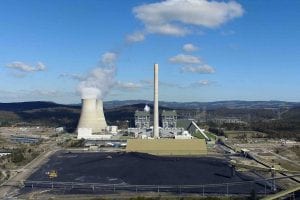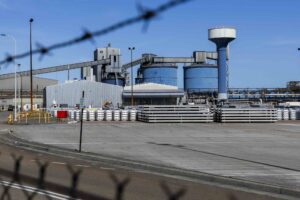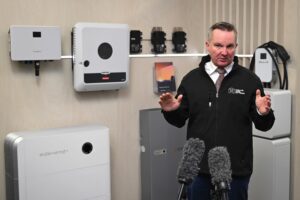
“There’s a dramatic transformation that’s taking place in Australia’s energy system, a once in a lifetime transformation as we move into the world of micro-grids, demand management, rooftop solar and battery storage.”
It’s the type of observation that readers might expect to read in a publication like Reneweconomy. But who was the forward-looking visionary who authored this statement? A university researcher? An evolved network owner? Someone seeing the future at AEMO (such as its CEO)? Or an environmental NGO?
No, it was federal environment and energy minister Josh Frydenberg, who made the comments to the Albury Border Mail as he visited the site of a proposed community solar farm a fortnight ago, and then talked to folk signed up to the ground-breaking Yackandandah micro-grid.
Frydenberg even repeated much of this line in parliament this week, when asked a Dorothy Dixer in question time by Cathy McGowan, the member for Indi who accompanied him on the tour.
Yes, this is the same Josh Frydenberg who has spent much of the last year and a half decrying the very people who want to embrace this transformation, decrying federal Labor’s 50 per cent renewable energy target “as reckless and irresponsible”, mocking the Tesla big battery, and launching any number of attacks against the former South Australia Labor government’s renewables initiatives.
And this is the same Josh Frydenberg who is trying to force the National Energy Guarantee upon the Australian energy market, browbeating the Labor states and territories into accepting that something must be better than nothing.
And this is the same policy proposal that – on evidence presented so far – intends to do the very opposite of the rapid transition lauded by Frydenberg. According to independent analysis, and its own modelling, it actually intends to throw progress on emissions and the renewable energy transition into reverse.
To convince people of the idea that the NEG is something that must be better than nothing, has required from Frydenberg and prime minister Malcolm Turnbull some political double-takes of breathtaking scope, and a level of deception designed to fool members of his own party, the media, and the energy industry itself.
The evidence is that they might be half way there.
The party room was won over first, with the promise that this was not a carbon price at all, and nor would it threaten the primacy of fossil fuels in Australia’s energy mix. The government even commissioned modelling that sought to tell them that the pace of renewable installations would be reversed rather than accelerated by the new policy.
An email, circulated to environmental NGOs and clean energy representatives in early February by Ben Skinner, formerly of the Australian Energy Market Operator, and now head of policy development at the lobby group Energy Supply Council, is revealing.
As Skinner explained in this email, in seeking support for the policy and understanding of the political theatrics, the original 8-page advice on the NEG presented to the government by the Energy Security Board was “written in an obtuse style” quite deliberately.
“This was partly because several parties held the pen, but also somewhat intentionally in order to manage the very difficult political situation at the time with respect to anything that could be interpreted as a form of carbon pricing. It was that writing style that got it through its most difficult hurdle in its first few days: I need say no more on that matter.”
Skinner’s observations are interesting, not just because of the content, which speaks for itself, but also because of his knowledge of the intent of the ESB letter. He left AEMO before Frydenberg officially asked the ESB – of which AEMO is a member – for an idea to help the Coalition out of its political fix in early October.
Skinner tells RenewEconomy that he had no involvement in the 8-page letter and that his observations were “circumstantial supposition.”
Still, it may leave open the suspicion that the NEG was something cooked up by what some refer to the “energy mafia” – including lobby groups like the ESC and the Business Council of Australia, who were so quick to support the idea when released; and the Minerals Council of Australia, whose former policy chief now directs climate traffic in Turnbull’s office.
With the internal party politics brought to heel with barely a whimper, the next target was the mainstream media, and its ability to put pressure on state governments.
And disturbingly, because mainstream media chooses to focus on politics rather than policy, this has proved no more an obstacle than the Coalition’s own party room.
The Murdoch media were obviously no issue, but even the Guardian quickly jumped on board, declaring that any opposition to the NEG by Labor would amount only to “playing politics.”
Fairfax, too, has been won over, with the Canberra Times writing an editorial last week, also published in The Age, imploring (following the defeat of the Labor government in South Australia) the Labor-Greens ACT government to support the NEG.
“ACT Labor and The Greens need to ask themselves if their ideological purity trumps the national interest,” the editorial thundered. “Surely 80 per cent of something has to be worth more than 100 per cent of nothing.”
Frydenberg’s office could hardly have been more pleased with the editorial than if they had written it themselves. But the Fairfax assertions are, of course, complete tripe.
And we know this because the third grouping that needs to be fooled for the NEG to proceed as planned is not so easily duped. And their detailed submissions have unveiled the biggest con about the NEG – that it is so ill-defined, so preliminary and so overwhelmed by complexity that it can barely be described as a plan.
It is certainly not 80 per cent advanced toward anything, and the Fairfax Media editorial writers should be ashamed and embarrassed for saying so and blindly picking up Coalition talking points.
Indeed, as currently conceived, the NEG will do the very opposite of what it pretends. Far from addressing the environmental, reliability and cost issues surrounding the National Electricity Market, it risks making each of them worse.
This is the substance of the more than 100 submissions from the industry itself from network owners, from retailers large and small, from renewable energy developers, battery and pumped hydro storage developers, software developers, and engineers.
To broadly summarise:
It will be worse than doing nothing. Several studies now point to the fact that on current policies, Australia will reach around 40 per cent renewables by 2040. The NEG seeks to cap this at 36 per cent by locking in an emissions target that is less than business as usual.
It is based around the assumption that the electricity industry’s emissions reduction target for 2030 should be 26 per cent. Yet new analysis has shown that emissions will fall by 29 per cent if there are no policy changes. So the NEG seeks to be worse than doing nothing.
It will lift prices rather than reduce them. For all the modelling that has been done on theoretically pass through mechanisms, there is one simple observation made by everyone – all the way from the ACCC, the networks, the small and medium-sized retailers and others: this design could kill competition. And that means higher prices. Full stop.
It is too complex. By trying to be something for everyone, particularly to the incumbents, and in trying to pretend that this won’t be some sort of carbon price, the designers have produced a plan of such complexity to be effectively unworkable.
The reliability guarantee makes no sense. The ESB haven’t even gotten around to spelling out the meaning of reliability, what technology will count towards it, and what won’t. Nor has it said how this can be managed.
It doesn’t actually address the problem. Frydenberg and Turnbull argue that the NEG is essential to delivering reliability. But as AEMO point out in their latest briefing, the NEG only addresses part of the problem. The rest must come from market design.
As the AEMO argues, the market rules are no longer fit for purpose, they favour ageing, increasingly redundant technologies, and simply don’t encourage investment in the smart technologies – those mentioned by Frydenberg at the start of this article.
What’s more, many in the industry, such as the government-owned Snowy Hydro, say that the reliability mechanism is not needed.
Others, such as Tesla and Genex, the respective builders of the Hornsdale big battery and a huge solar-pumped hydro storage facility in Queensland, say that the legislation could have the perverse effect of discouraging investment in battery storage and pumped hydro, the very technologies the ESB says are needed.
Despite all this, the ESB has said it intends to plough on and present a “high-level” design of the NEG, taking in the substance of the submissions it received just a few weeks ago, to COAG energy ministers soon after Easter.
But there appears to be too many spools to unravel. Requests have been made to shift the burden from retailers to generators, or to exclude smaller retailers. There is nothing to suggest these suggestions will be taken up.
The policy also needs to dovetail with the Integrated Security Plan being developed by AEMO, and the numerous other market rules seen as essential to usher in that glorious transition that Frydenberg occasionally admits is upon us.
It also needs to sort out – possibly among the ESB members themselves – whether this policy sees the energy market as a synchronous machine and seeks ways to protect it, or one that will see rapidly evolving technologies and management. One view is to raise barriers to the future, the other seeks to lower the drawbridge.
But the content of this won’t become clear until August, when the final design begins to emerge (presuming that further work is approved at the April COAG meeting).
It may be that the ESB can pull a rabbit out of the hat and deliver a workable, meaningful and forward-looking policy. Many certainly hope so. But until this happens, the NEG cannot be considered as 80 per cent towards anything, and should be treated with at least some degree of skepticism and hard analysis until it is.










